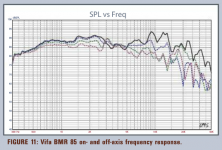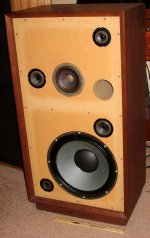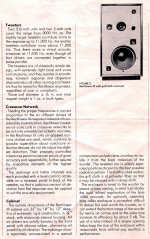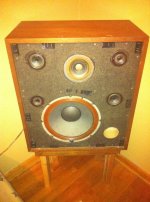Appears to me that this driver should not be used fullrange. Isn't that a dipole null created by the manner a BMR functions? I think yes.
The lacking top octave can be due to the voice coil inductance of this particular driver. In the frequency range where a driver works modally there are no dipole effects. A large DML pannel doesn't sound like a dipole. The BMR in an 18 cm round baffle (just trying) does. This an other way of getting rid of the strange location phenomenon (if you like dipoles).
Au contraire my friend, it most certainly does have this effect at play. Look how the driver "cone" is by designed function with mass loading the center creates a dual mode of operation. One inner and one outer, the added mass is to balance this mode but none the less does behave in this way due to the difference in acoustic pressure has far greater effect on the outer edge, where as the pressure on the inner is compensated with mass. Read the pdf you posted, it says the same thing but leaving out this not so little detail.
It's hard to explain as I'm pulling from knowledge of aerodynamics and I'm not a Ph.D Physicist. Perhaps a few more well versed on the mechanical properties will chime in to explain in better detail.
🙂
It's hard to explain as I'm pulling from knowledge of aerodynamics and I'm not a Ph.D Physicist. Perhaps a few more well versed on the mechanical properties will chime in to explain in better detail.
🙂
The measurements show an excellent independence of the FR from listening direction
Could you please post those measurements?
You're using ARTA, right? Could you please export the impulse responses as .wav and post them?
The Hiwave has better constant directivity in the 5-10 kHz range, but not the treble extension. But also the Viva will be quite far down at 20 hHz in flooder mode, so the Hiwave together with a rear-firing supertweeter would probably be the best solution.
The Hiwave has an unusually heavy diaphragm for such a small driver, which is responsible for its different treble response, but also for its terrible sensitivity.
HiWave Balanced-Mode Radiator BMR65-8
And yes, there is a null 🙂
HiWave Balanced-Mode Radiator BMR65-8
And yes, there is a null 🙂
The point I was trying to make wasn't specifically about which BMR driver being used, but rather how they all function. For yours I wouldn't cross above 2,5-2,7kHz and add a tweeter from there for best sound. BTW a conventional driver of the same size would be crossed 5k, maybe a tad higher.
Senstivity is relatively low for all of them I've seen.
Please post up some ARTA measurements
Senstivity is relatively low for all of them I've seen.
Please post up some ARTA measurements
But also the Viva will be quite far down at 20 hHz in flooder mode, so the Hiwave together with a rear-firing supertweeter would probably be the best solution.
but how and why it give a outstanding stereo?
but how and why it give a outstanding stereo?
I bought it for comparison to my own wide-beam fullrange driver and only tried it mono. But from its strange spacial effects I am quite sure it doesn't give suitable stereo front-firing. Whether it is better/worse than a rising response beamy driver in flooder mode, I don't know. As I said, tests only in mono. My BMR won't get the honour of landing in a speaker, but if one had a serious interest, I would give him the advice to set the BMR on top, a lowpassed bafflestep filler in front and a little polycarbonate supertweeter (with 10 dB more sensitivity) to the rear.
The material for my next prototype is ordered, no more measurements before it's ready.
Last edited:
In a Finnish magazine in 1984 there was a DIY project using a plurality of elements in each freq band. Those could resemble some function of decorrelating the off-axis signals. Elements are placed in a quite random manner, like blasted by a shotgun.
It says in the pic: "controlled directivity"
Is this the way to mimic "bending wave" directivity and decorrelation of off-axis signal by using conventional dynamic drivers ?
Here's another speaker Rectilinear III using similar semirandomly placed multible tweeter method. (see more pics here Vintage 70's Stereo System)
Tweeters operate above 3 kHz, and are crossed with 1st order filter.
The spacing of the tweeters is much longer than wavelength in the operation freqs. This is very smart, because the off-axis response varies semirandomly with spatial angle.
This can potentially give some remedy to the terrirble stereophonic cross talk comb filtering, which otherwise manifests itself in "naked ugliness" as Toole puts it in his book.
In the past people were smarter ? 😉 Where has all this knowledge gone ?

Attachments
"naked ugliness" as Toole puts it in his book.
"Not to be ignored in any situation in which refl ected sounds have been
removed is the fact that the acoustical crosstalk that plagues stereo phantom
images is present in its naked ugliness, without any compensation from refl ected
sounds (see Figure 9.7). One hopes that recording engineers in these situations
do not attempt to remedy it with equalization. If they do, their compensation
would be excessive for normally refl ective rooms [...]"
That's exactly what recording engineers do. How could it be any different? They apply EQ and effects based on what they hear. The control room is where the original emerges.
Here's another speaker Rectilinear III using similar semirandomly placed multible tweeter method.
This model seems to be already from 1960's.
Also there seems to be another version of this speaker with lower height:
http://i.imgur.com/jcjMS.jpg
The tweeters are considerably far from each others.
Attachments
Last edited:
That's exactly what recording engineers do. How could it be any different? They apply EQ and effects based on what they hear. The control room is where the original emerges.
Here I agree with Toole.
Recording engineers do it wrong 🙂
You are presenting a question: "How could it be any different?" After such a question one has to ponder if you have read Tooles book or not ? 😉 Because the answer is there, for sure. It can be different. And it should be different. We can do it differently.
Here's another speaker Rectilinear III using similar semirandomly placed multible tweeter method. (see more pics here Vintage 70's Stereo System)
In the past people were smarter ? 😉 Where has all this knowledge gone ?
Perhaps they were smarter, but we know more now, and one of the things we learned is that you shouldn't sprinkle tweeters all over a baffle.
- Status
- Not open for further replies.
- Home
- Loudspeakers
- Multi-Way
- Unconventional Techniques for Achieving Oustanding Stereo Imaging



